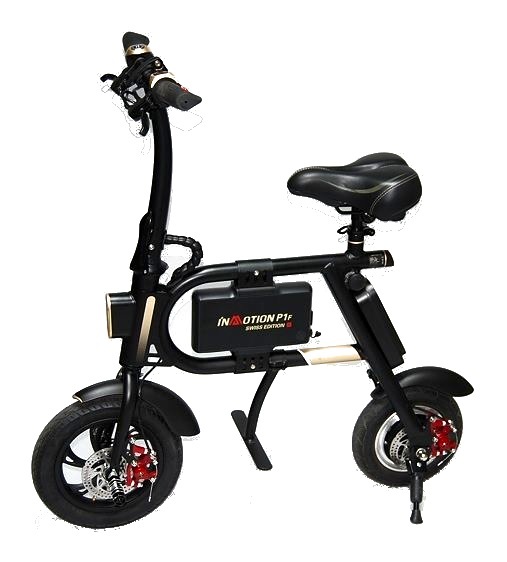Short feedback on the Inmotion P1F, have one of those for more than a year now… about 300km on it now, no problems. Practical range is 20km, max speed 30kmh, fits nicely in luggage area, and is kinda cute 

I wonder if anyone has seen this one. It should fit into most baggage areas and is quite light (15 kgs) for an e-bike.
Went to try the Brompton today and it’s very well made, light and super small when folded.
I’m now in doubt between the normal and the electric one. The electric one gives a lot more flexibility if an airport is a far away from towns or in hilly areas (and simplifies my daughter’s and my life), but I am concerned about carrying 2 batteries on board that might be dangerous and are prohibited on commercial flights.
I also wonder whether is is allowed to carry those batteries on private flights: do you know if there are any restrictions that apply to GA private flights? I am a bit surprised if there’s no rule on GA for something that on airliners is strictly forbidden…
I also wonder whether is is allowed to carry those batteries on private flights
It’s OK to carry your bike, like knives, Avgas, TKS onboard cockpit of GA aircraft, they are prohibited on comercial flights but on private flights they are OK if they facilitate flight safety (see NCO.GEN.140, it gives a lot of leeway on what to take)
I would be more worried about Samsung phone batteries but you should would have one fire bag? and know how to throw it out of the window?
You can’t throw Samsung phones out of pressurised cockpits at FL380 unlike in private open vintage cockpits, so the tolerances are slightly different…
NicoKM wrote:
I am a bit surprised if there’s no rule on GA for something that on airliners is strictly forbidden…
Oh yes, there is! Check NCO.GEN.140 with its AMC and GM – about 5 pages in all. You’ll find it in the Air Ops regulation.
@Ibra, phone/tablet battery fires are more containable than a much more powerful Brompton battery catching fire. I can’t picture a viable container for them, and you need to open the door to throw one of them out, assuming you can pick it up with your hands while it burns…
Thanks for pointing me to the regulation, will read it.
In the end I believe it boils down to accepting or not an additional risk onboard.
Which means I could go for electric and decide to carry or not the batteries based on how manageable that risk can be, and how much value the e-bike adds for that trip, assessing it flight by flight. If I don’t bring the batteries, in the end the bicycles are just basic Bromptons and they can still take you to places, only more sweaty ;)
How often to batteries catch fire of they are not on charge?
only more sweaty ;)
Climbing trouville hill with “legs only cycling” using a small folding and quickly get into aircraft at LFRG triggers more TEM than a disconnected electric battery 
From NCO.GEN.140 (thanks for the link)
Dangerous goods shall only be transported by the operator approved in accordance with
Annex V (Part-SPA), Subpart G, to Regulation (EU) No 965/2012 except when:
(1) they are not subject to the Technical Instructions in accordance with Part 1 of those
Instructions; or
(2) they are carried by passengers or the pilot-in-command, or are in baggage, in accordance
with Part 8 of the Technical Instructions;
(3) they are carried by operators of ELA2 aircraft.
Following definitions apply (COMMISSION REGULATION (EC) No 748/2012, article 1):
“ELA1 aircraft” means the following manned European Light Aircraft:
an aeroplane with a Maximum Take-off Mass (MTOM) of 1200 kg or less that is not classified as “complex motor-powered aircraft”;
a sailplane or powered sailplane of 1200 kg MTOM or less;
a balloon with a maximum design lifting gas or hot air volume of not more than 3400 m3 for hot air balloons, 1050 m3 for gas balloons, 300 m3 for tethered gas balloons;
an airship designed for not more than four occupants and a maximum design lifting gas or hot air volume of not more than 3400 m3 for hot air airships and 1000 m3 for gas airships;
“ELA2 aircraft” means the following manned European Light Aircraft:
an aeroplane with a Maximum Take-off Mass (MTOM) of 2000 kg or less that is not classified as “complex motor-powered aircraft”;
a sailplane or powered sailplane of 2000 kg MTOM or less;
a balloon;
a hot air ship;
a gas airship meeting all of the following elements:
3% maximum static heaviness,
Non-vectored thrust (except reverse thrust),
Conventional and simple design of: structure, control system and ballonet system
Non-power assisted controls;
a Very Light Rotorcraft.
A lot of us would qualify as ELA2 aircraft, so looks like we are allowed to carry dangerous goods. I haven’t got to what conditions come with the carriage thought!
As for them going on fire, I don’t think that poses much risk IF
1. You buy a reputable brand (not some cheap Chinese nock off copy
2. You aren’t attempting to charge in flight
3. You load it in such as way that there is no risk of movement and the battery getting knocked (or worse still punctured) in flight.
4. You aren’t deal with extreme temperatures (either in flight or while left on the ground).
Not all lithium batteries are equal; LiFePO4 batteries are vastly less likely to go on fire than LiPoly. Given the much better longevity of LiFePO4, do Brompton use them for the electric bikes?